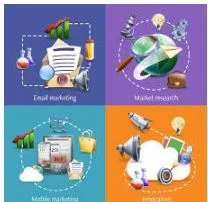Digital Marketing in 2025: How Companies Are Leveraging Influencer Marketing for Growth
In today’s hyper-connected world, digital marketing is evolving at a breakneck pace. As we move deeper into 2025, companies seeking to stand out are increasingly harnessing the power of influencer marketing to reach and engage target audiences in more authentic, impactful ways. For organizations striving to optimize their brand’s visibility and trust in competitive markets, digital partners like https://daycatchhk.com/ are playing an instrumental role in crafting effective influencer marketing strategies that drive measurable business growth.
The New Era of Digital Marketing
The digital marketing landscape has undergone seismic shifts in the past decade. Advances in data analytics, artificial intelligence, content automation, and user experience have redefined how brands interact with consumers. Yet, amid all these technological innovations, one trend has emerged as a game-changing force: the rise of influencer marketing.
According to a 2024 report by Statista, global spending on influencer marketing reached $35 billion, up from just $13.8 billion in 2021. This surge is not coincidental. As traditional advertising loses traction with increasingly ad-weary audiences, influencer marketing offers a solution rooted in authenticity, trust, and community engagement.
What Is Influencer Marketing in 2025?
Influencer marketing is no longer just about celebrities posting branded photos on social media. In 2025, it has matured into a sophisticated, data-driven discipline that leverages individuals with established credibility and dedicated followings to promote products, services, and ideas.
Today’s influencer marketing campaigns are characterized by:
- Micro and nano influencers with smaller, but more engaged, niche audiences.
- Data-backed selection of influencers based on audience demographics, psychographics, and buying behavior.
- Long-term partnerships between brands and influencers, rather than one-off, transactional collaborations.
- Integration with broader digital strategies, including SEO, paid media, and content marketing.
- AI-powered analytics to track ROI, engagement, and sentiment in real time.
Why Influencer Marketing Works in 2025
1. Authenticity and Trust
Consumers in 2025 are more discerning than ever. Bombarded with ads across every platform, they crave authentic voices and genuine recommendations. A Nielsen study from late 2024 found that 88% of global consumers trust recommendations from people they know or follow online over traditional advertisements. Influencers, by virtue of their established rapport with followers, act as trusted intermediaries between brands and consumers.
2. Hyper-Targeted Reach
Advanced analytics enable brands to identify and collaborate with influencers whose audiences align perfectly with their target demographics. Whether it’s a tech start-up aiming for Gen Z gamers or a beauty brand seeking eco-conscious millennials, influencer marketing delivers messages to the right people, in the right tone, at the right time.
3. Content That Resonates
Influencers are expert content creators. They understand what their followers respond to and can craft visually compelling, relatable, and on-trend content that seamlessly integrates brand messaging. This is especially crucial as platforms like TikTok, Instagram Reels, and YouTube Shorts continue to dominate user attention in 2025.
4. Agility and Speed
The digital world moves fast. Influencer marketing allows brands to respond quickly to trends, cultural moments, and breaking news. With the right partnerships, a campaign can go from concept to viral sensation in a matter of days.
5. Measurable Impact
Thanks to AI-powered tracking tools, companies can now measure the impact of influencer collaborations with unprecedented accuracy. Metrics such as engagement rates, conversion rates, sentiment analysis, and even offline sales attribution are standard features of modern influencer campaigns.
Influencer Marketing Strategies for Companies in 2025
1. Building Long-Term Partnerships
Gone are the days of one-off sponsored posts. In 2025, brands are investing in long-term relationships with influencers who genuinely align with their values and vision. This approach fosters greater authenticity, deeper brand storytelling, and stronger audience trust.
2. Embracing Micro and Nano Influencers
While mega-influencers and celebrities still hold sway, companies are increasingly turning to micro (10,000–100,000 followers) and nano influencers (fewer than 10,000 followers) for their higher engagement rates and niche appeal. These influencers often have tight-knit communities and are perceived as more accessible and relatable.
3. Leveraging Multi-Platform Campaigns
A successful influencer marketing strategy in 2025 spans multiple platforms. Brands collaborate with influencers to create content tailored for each channel—Instagram for visuals, TikTok for trends, YouTube for long-form stories, and even emerging platforms like BeReal and Lemon8 for authenticity and behind-the-scenes glimpses.
4. Integrating AI and Data Analytics
AI-driven platforms now help companies match with ideal influencers, predict campaign outcomes, and optimize content in real time. These platforms analyze vast datasets, including audience sentiment, engagement patterns, and competitor activity, to ensure maximum ROI.
5. Focusing on Social Commerce
Influencer-driven social commerce—where product recommendations are seamlessly integrated into the purchasing journey—is booming. Platforms like Instagram and TikTok offer in-app shopping, allowing users to buy featured products without leaving the platform. Influencers act as both marketers and salespeople, guiding followers from discovery to conversion.
6. Prioritizing Transparency and Regulation
With the rise of influencer marketing, regulatory bodies in regions like the EU, US, and Asia-Pacific have introduced stricter guidelines around disclosure and transparency. Companies must ensure that influencer partnerships are clearly labeled as sponsored content, protecting both consumers and brand reputation.
Case Studies: Influencer Marketing in Action
Beauty and Skincare
In the beauty sector, brands like Fenty Beauty and Glossier have thrived by collaborating with micro-influencers and makeup artists who showcase products in daily routines and tutorials. This user-generated content drives authentic engagement and fuels community-driven growth.
Technology and Gaming
Gaming brands have made influencer marketing central to their go-to-market strategies. Product launches are often accompanied by live streams from popular gamers, unboxing videos, and real-time Q&A sessions, creating a buzz that paid ads alone can’t match.
Food and Beverage
Restaurant chains and food brands partner with local foodies and chefs, leveraging their credibility to introduce new menu items or promote limited-time offers. Influencer-hosted tasting events, recipe videos, and interactive challenges drive both online and in-store traffic.
Fashion and Lifestyle
Sustainable fashion brands work with eco-conscious influencers to highlight their ethical sourcing, craftsmanship, and environmental impact. This approach taps into communities that prioritize values-driven purchasing decisions.
Navigating Challenges in Influencer Marketing
While influencer marketing offers vast opportunities, companies must also navigate several challenges:
- Finding the right influencers: Not every influencer is a fit for every brand. Authentic alignment and thorough vetting are essential.
- Managing costs and ROI: Influencer rates can vary widely. Data-driven negotiation and performance-based compensation models are increasingly common.
- Ensuring authenticity: Audiences are quick to spot inauthentic partnerships. Companies must prioritize organic, value-driven collaborations.
- Staying compliant: As regulations evolve, brands must remain vigilant about disclosure requirements and data privacy.
The Role of Digital Marketing Agencies
As influencer marketing becomes increasingly complex, digital marketing agencies like https://daycatchhk.com/ are invaluable partners. They provide:
- Expertise in influencer discovery and vetting
- Strategy development and campaign management
- Content creation and creative direction
- AI-driven analytics and reporting
- Compliance with local and international regulations
These agencies offer end-to-end solutions, freeing companies to focus on their core business while maximizing the impact of their marketing spend.
Emerging Trends in Influencer Marketing for 2025 and Beyond
AI-Generated Influencers
Virtual influencers—AI-generated personalities—are gaining traction. These digital avatars can reach millions without the unpredictability of human influencers, yet still offer unique storytelling opportunities.
Decentralized Influence
With the rise of decentralized social platforms and blockchain technology, influence is becoming more democratized. Audiences now co-create content, vote on brand collaborations, and even share in campaign rewards.
Live Shopping Experiences
Live commerce, popularized in China and rapidly spreading worldwide, combines influencer-hosted streams with instant purchasing options, creating immersive, interactive shopping experiences.
Hyperlocal Campaigns
Brands are investing in hyperlocal influencer campaigns to reach communities with tailored messaging, particularly in emerging markets where local voices carry significant weight.
The Future: Influencer Marketing as a Business Imperative
In 2025, influencer marketing is not just a trend—it’s a business imperative. Companies that master this discipline will enjoy stronger brand equity, deeper customer relationships, and a measurable edge over competitors. As consumer trust in traditional advertising continues to wane, influencer partnerships—rooted in authenticity, creativity, and shared values—are the key to sustained growth.
For organizations ready to embrace the future, now is the time to invest in smart, data-driven influencer marketing strategies that adapt to changing platforms, regulations, and audience expectations.
Author Bio:
With a background in digital media and brand communications, the author has spent over a decade helping global companies navigate the evolving world of influencer marketing, content strategy, and analytics. Passionate about bridging storytelling and technology, the author delivers insights that empower brands to thrive in the fast-paced digital landscape.





